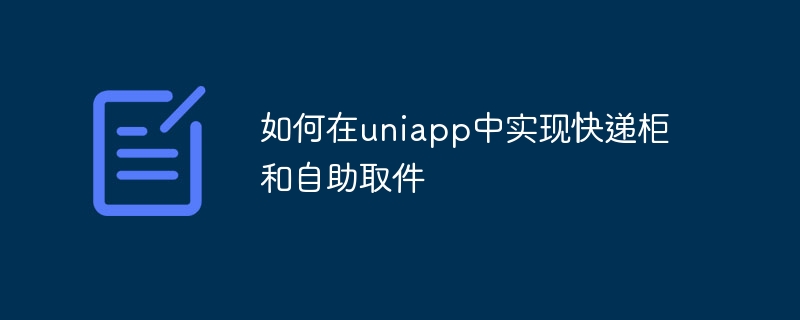Home >Web Front-end >uni-app >How to implement express cabinets and self-service pickup in uniapp
How to implement express cabinets and self-service pickup in uniapp
- 王林Original
- 2023-10-21 08:19:551109browse

How to implement express lockers and self-service pickup in uniapp
With the popularity of e-commerce and the rapid growth of express delivery business, express lockers and self-service pickup services have become an integral part of daily life. By implementing express cabinet and self-service pickup functions in uniapp, users can be provided with a more convenient and faster pickup method. This article will introduce how to implement express cabinet and self-service pickup functions in uniapp, and provide corresponding code examples.
- Design the data structure of the express cabinet
First, we need to design the data structure of the express cabinet, including the express cabinet number, express order number, express status and other information. You can use the data attribute in Vue to store this information. The sample code is as follows:
data() {
return {
lockers: [
{ id: 1, expressNo: '', status: 0 }, // 状态0表示该柜子为空
{ id: 2, expressNo: '', status: 0 },
{ id: 3, expressNo: '', status: 0 },
// ...
]
}
}- Display the express cabinet list
In the page component of uniapp, you can usev- The forinstruction loops through the express cabinet data and displays it using theviewcomponent. The sample code is as follows:
<view>
<view v-for="(locker, index) in lockers" :key="index">
<text>{{ locker.id }}</text>
<text>{{ locker.expressNo }}</text>
</view>
</view>- Implementing the self-service pickup function
After the user enters the courier number on the self-service pickup page, click the pickup button. In uniapp, the click-triggered function can be implemented through the@clickevent of the button. The sample code is as follows:
<view> <input v-model="expressNo" placeholder="请输入快递单号"></input> <button @click="retrieveExpress">取件</button> </view>
In uniapp, you can use the methods attribute to define the triggered function. The sample code is as follows:
methods: {
retrieveExpress() {
// 根据快递单号查找对应的柜子并更新状态
for(let i = 0; i < this.lockers.length; i++) {
if(this.lockers[i].expressNo === this.expressNo && this.lockers[i].status === 1) {
this.lockers[i].status = 0;
this.expressNo = '';
// 弹出提示框,表示取件成功
uni.showToast({
title: '取件成功',
icon: 'success'
});
return;
}
}
// 弹出提示框,表示取件失败
uni.showToast({
title: '取件失败,请检查快递单号或柜子是否存在',
icon: 'none'
});
}
}- Implement express delivery Storage function
When the user needs to store express delivery, we need to bind the express delivery order number entered by the user to the cabinet number, and update the status of the corresponding cabinet. The sample code is as follows:
<view> <input v-model="expressNo" placeholder="请输入快递单号"></input> <input v-model="lockerId" placeholder="请输入柜子编号"></input> <button @click="storeExpress">存件</button> </view>
methods: {
storeExpress() {
for(let i = 0; i < this.lockers.length; i++) {
if(this.lockers[i].id === parseInt(this.lockerId) && this.lockers[i].status === 0) {
this.lockers[i].status = 1;
this.lockers[i].expressNo = this.expressNo;
this.expressNo = '';
this.lockerId = '';
// 弹出提示框,表示存件成功
uni.showToast({
title: '存件成功',
icon: 'success'
});
return;
}
}
// 弹出提示框,表示存件失败
uni.showToast({
title: '存件失败,请检查柜子编号或柜子是否已满',
icon: 'none'
});
}
}Through the above steps, we have implemented the basic logic of the express cabinet and self-service pickup functions in uniapp, allowing users to conveniently and quickly perform express storage and pickup operations. Of course, the above code is only an example, and the specific implementation needs to be adjusted and expanded according to project needs.
The above is the detailed content of How to implement express cabinets and self-service pickup in uniapp. For more information, please follow other related articles on the PHP Chinese website!

